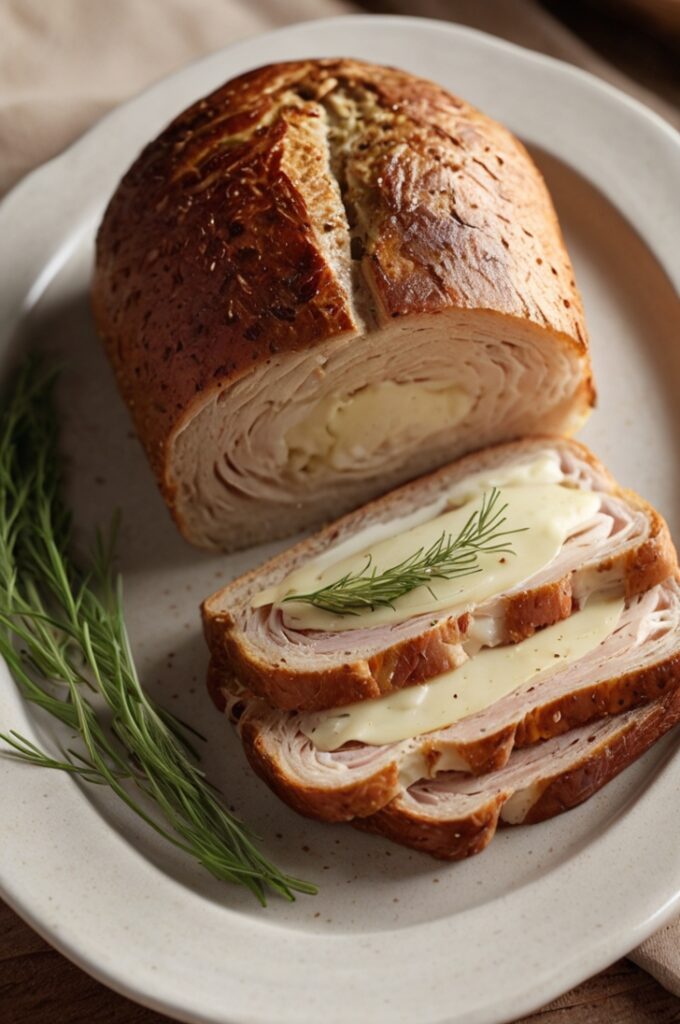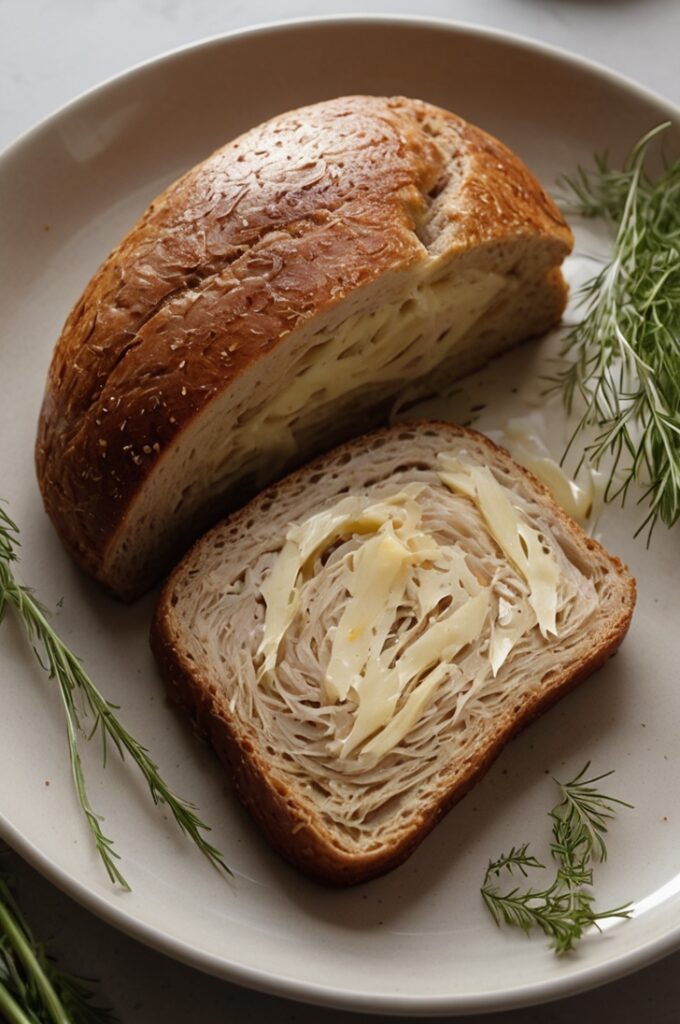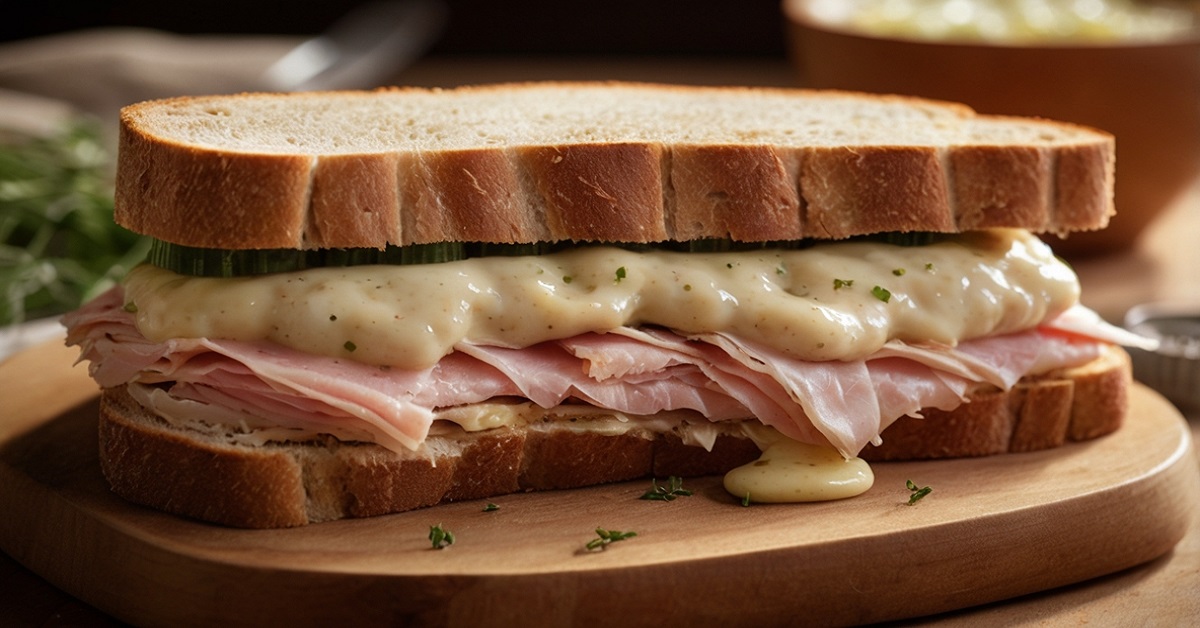It was a cold Tuesday afternoon when I first bit into a Rachel. Not the Reuben. The Rachel. Ultimate Rachel Sandwich Recipe kind of day, if you ask me.
My friend’s grandma made it on a pan so old it might’ve cooked Eisenhower breakfast, and it crackled when it hit the griddle. The bread crisped like brittle autumn leaves. Turkey, Swiss, sauerkraut, Russian dressing hot, messy, tangy brilliance. It was a forkless masterpiece.
Now here’s the kicker. Most folks think of the Rachel as Reuben’s shy little sister. Uh-uh. Not in my kitchen. This sandwich is fierce. A perfect storm of textures, temperatures, and fermented funk that just hits right. And when made right really right it’s one of the best hot sandwiches in the American deli canon.
Let’s get into the nitty gritty. Not just the how. But the why. The what-makes-it-sing kinda talk.
What Is a Rachel Sandwich, Anyway?

You take a Reuben. Swap the corned beef for turkey. Trade Russian dressing if you like, maybe even coleslaw instead of sauerkraut (more on that in a sec). The Rachel’s got flexibility, and that’s part of its charm.
But don’t let that fool you. She ain’t sloppy seconds. She’s sharper, lighter, funkier, and just a touch more modern.
Where the Reuben wraps you up in wool and nostalgia, the Rachel pops like jazz through tin speakers in a corner diner. Same genre, different groove.
Let’s talk ingredients.
Ingredients & Substitutions
For one hefty sandwich:
- 2 slices Jewish rye bread (seeded preferred)
- 4–5 oz sliced roasted turkey breast
- ¼ cup sauerkraut (drained, not dry)
- 2 slices Swiss cheese (Emmental or Gruyère also work)
- 1½ tbsp Russian dressing (or Thousand Island, if you must)
- Softened butter (for the bread)
Substitutes & Notes:
Bread: Rye is classic, but if you’re in a pinch, sourdough’s got the backbone. Pumpernickel adds depth, too. Don’t even think about using plain white sandwich slices. No body, no bite.
Turkey: Use fresh roasted if you can leftovers from a roast bird are dreamy. Deli turkey works, but go for oven-roasted, not that slimy “honey” kind.
Sauerkraut: Buy raw kraut if you can. Unpasteurized kraut has brighter tang and actual probiotic funk. Jarred is fine, just rinse and dry it slightly. Bagged kraut often tastes like regret. Avoid.
Dressing: Russian dressing’s got kick. Ketchup, mayo, horseradish, Worcestershire, paprika. Thousand Island is the sweet cousin. Want a sharper twist? Add a few drops of pickle juice or a spoon of grated shallot.
Cheese: Swiss melts like a dream but isn’t the only option. Havarti is smooth. Provolone brings salt. Fontina is…chef’s kiss.
Step-by-Step Instructions (With Expert Tweaks)
- Prep the kraut.
Drain it. Press it gently between paper towels. Not bone dry, but soggy kraut will steam your bread, not crisp it. And we want crackle, not sog. - Butter the rye.
Spread butter on one side of each slice. Edge to edge. Think of it like sunscreen don’t miss a spot or you’ll burn. - Build it cold.
On the non-buttered sides, layer: one slice of cheese, then turkey, then kraut, then dressing, then second slice of cheese. Top with the other bread slice, butter out. That cheese-on-both-sides trick? It seals everything in when melted. - Griddle time.
Medium-low heat. Cast iron pan if you’ve got it nothing browns like it. Press gently with a spatula. Not a panini press, not a bench press. Just enough to say, “Stay close, friends.” - Flip once.
About 3–4 minutes per side. Golden. Crisp. Cheese melting like lava. If the bread browns before cheese melts, lower the heat and cover it for a minute. Cheese should stretch when pulled. - Rest, then cut.
Let it sit 30 seconds before slicing. Diagonal, always. Nobody trusts a person who cuts sandwiches straight across. Don’t ask me why. Just truth.
Variation alert: Swap kraut for coleslaw if you want a creamier, crunchier vibe. Add pastrami for a smoky twist. Rye getting stale? Turn it into a Rachel melt in a skillet, open-faced.
Cooking Techniques & Science Behind the Crunch
Let’s break it down like we’re talking shop at a kitchen pass.
Butter on the outside = Maillard reaction jackpot. The milk solids brown. The fat crisps. This ain’t grilled cheese science. This is sandwich alchemy.
Cold build before hot press. Ever melt cheese too soon? The whole thing slips apart like a sad lasagna. Layering cold lets the structure firm up, and it all melts together.
Low-and-slow vs high heat. High heat? You’ll char the outside, raw inside. Low-and-slow gives the cheese time to surrender.
The kraut’s acidity? It cuts the fat. Think wine with steak. Fermentation balances the richness of the turkey and cheese.
Tool talk: Cast iron or heavy-bottomed skillet, always. Non-stick works in a rush. Don’t use a sandwich press unless you want uniform sadness. Texture comes from imperfect edges and caramelization not compression.
Serving & Pairing Suggestions
Serve it hot. Never lukewarm. Never cold. That’s criminal.
On the side? Go classic:
- Half-sour pickles. Crisp, briny, bright.
- Kettle chips. Something with real crunch to stand up to the melt.
- A bowl of matzo ball soup if you’re leaning into deli mode.
- Beer? A crisp pilsner. Wine? Dry Riesling. Soda? Dr. Brown’s Cel-Ray, if you know, you know.
Plating tip: Diagonal slice on a wooden board. Touch of kraut on the side. Maybe a ramekin of extra dressing. Make it look like someone cared.
This ain’t a sad desk sandwich. It’s a centerpiece.
What Makes the Rachel Special?

Balance.
Hot and cold. Creamy and tangy. Melty and crisp.
It’s a study in contrast each bite layered, nuanced, evolving. And unlike many hot sandwiches, the Rachel can actually taste refined. There’s depth. Personality. History.
It’s also endlessly customizable. Make it low-carb with a lettuce wrap (I mean, if you must). Do it on gluten-free sourdough. Swap turkey for roast chicken thighs, smoked duck, or tempeh if you’re feeling wild.
Once you understand the soul of it, the technique the ratio you can riff forever.
FAQs About Ultimate Rachel Sandwich Recipe
1. Can I make a Rachel sandwich ahead of time?
It’s best hot off the griddle. If you must prep ahead, build it cold and grill just before serving. Reheating makes the kraut soggy and the bread limp.
2. What’s the best kind of turkey to use?
Fresh-roasted turkey breast has the best texture and flavor. Deli-sliced works in a pinch, but skip ultra-thin cuts they’ll disappear.
3. Is there a vegetarian version of the Rachel?
Absolutely. Try thick slices of roasted portobello or tempeh. Still use kraut, cheese, and dressing for that iconic punch.
4. Can I use mayo instead of Russian dressing?
Technically yes, but then it ain’t a Rachel. Russian dressing brings spice, sweetness, and complexity mayo lacks.
5. What’s the difference between a Rachel and a Reuben?
Reuben = corned beef, sauerkraut, Swiss, Russian, rye. Rachel = turkey, sometimes coleslaw, same cheese and dressing.
In the end, the Rachel sandwich is like jazz.
A little improvisation. A whole lotta soul. Crisp edges, funky middle. If made right, it’s a sandwich you’ll think about hours later, maybe even dream about.
Don’t overthink it. Respect it. Griddle it with love.
And please cut it diagonal.
Final Expert Tips
- Steam-cheese melt trick: Add a tablespoon of water to the pan and cover it for 20 seconds. Steam = fast, full melt without burning the bread.
- Russian dressing in advance. Make it a day ahead. Flavors mellow, deepen.
- Avoid wet kraut. Always. Soggy kraut is sandwich sabotage.
- Don’t stack it tall. More isn’t more. A Rachel needs balance, not height.
- Use real butter. Margarine? Don’t make me curse in Yiddish.




